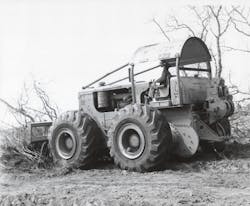The Archives of the Historical Construction Equipment Association is home to roughly 200,000 images, in digital or physical form. As might be expected, information is not readily available on many of them. The image in this column is among those.
The image shows a large Caterpillar crawler tractor on rubber tires, wielding a clearing rake against heavy vegetation. There was no hint—negative number, caption, or anything else—to indicate who took it. The tractor clearly wasn’t one of the famous Sugar Baby wheeled D6s; on the contrary, it was a modified D9. This was news to me, and I put the word out that I needed help with it.
The resulting series of e-mail conversations produced an unprecedented outcome: All three of the experts I usually consult about such matters—Eric Orlemann, Roger Amato, and Keith Haddock—were stumped. Eric noted that it was apparently a D9D and suggested I ask Eileen Grafton, historian for Peterson Cat, if it might be one of their conversions. No, she had nothing either.
But Grafton and the late author Edgar Browning noted the “St. Joe Land” name crudely painted on the rake, and recognized it as still being in business. An e-mail produced a reply from Dave Harrelson, SVP of St. Joe Timberland Co. of Delaware, who told the story of this machine.
In the late 1950s and early 1960s, St. Joseph Land & Development Co. was clearing scrub oak and wiregrass from thousands of acres of west Florida land, and replanting the land with pine tree plantations. Warren Settlemire supervised the operations, and he designed and built a custom root rake for use on a D7. In addition, a rubber-tired tractor was used to stack the debris. Setttlemire had converted a D8 and a D9 to rubber, and the St. Joe shop apparently did the work.
In the meantime, a friend of Browning—Richard Campbell of New Zealand—sent information on what he referred to as a King Ranch Special. The rig was what model railroaders call a kitbash, assembled from parts of unrelated sources. It consisted of a 19A series D9D, riding on the tandem axles of a No. 14-D motor grader and driver wheels and tires from a DW20 wheel tractor. The 19A was chosen because its torque converter (as opposed to the 18A’s direct drive) enabled it to skid-steer and not stall in a turn.
The Historical Construction Equipment Association is a 501(c)3 nonprofit organization dedicated to preserving the history of the construction, dredging, and surface mining equipment industries. With over 3,600 members in 25 countries, activities include publication of a quarterly educational magazine, Equipment Echoes, from which this article is adapted; operation of National Construction Equipment Museum and archives in Bowling Green, Ohio; and hosting an annual working exhibition of restored construction equipment. Our next International Convention and Old Equipment Exhibition will be September 22-24, 2023, at the National Construction Equipment Museum in Bowling Green, Ohio. The HCEA is raising funds for construction of a new purpose-built building to house its equipment collection, and the Convention will feature groundbreaking for it. Individual annual memberships in the HCEA are $35 within the U.S. and Canada, and $55 elsewhere. We seek to develop relationships in the equipment manufacturing industry, and we offer a college scholarship for engineering and construction management students. Information is available at www.hcea.net, or by calling 419.352.5616 or e-mailing [email protected].
About the Author
Tom Berry
Tom Berry is archivist for the Historical Construction Equipment Association (HCEA). Information is available at www.hcea. net, or by calling 419.352.5616 or e-mailing [email protected].
